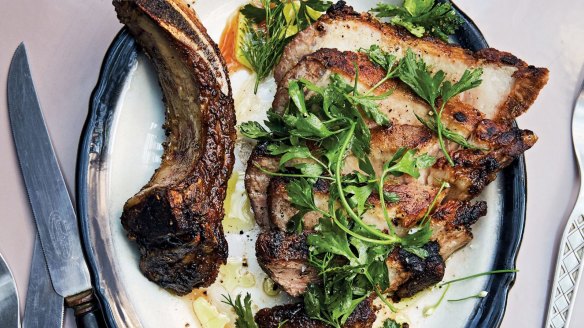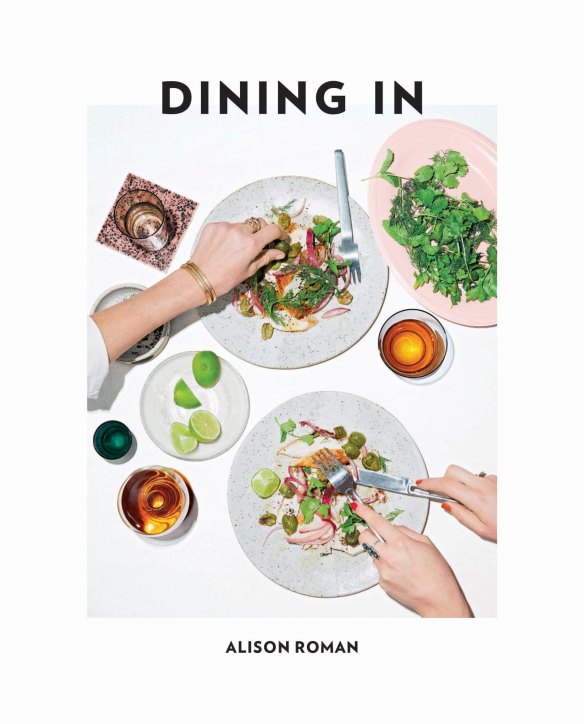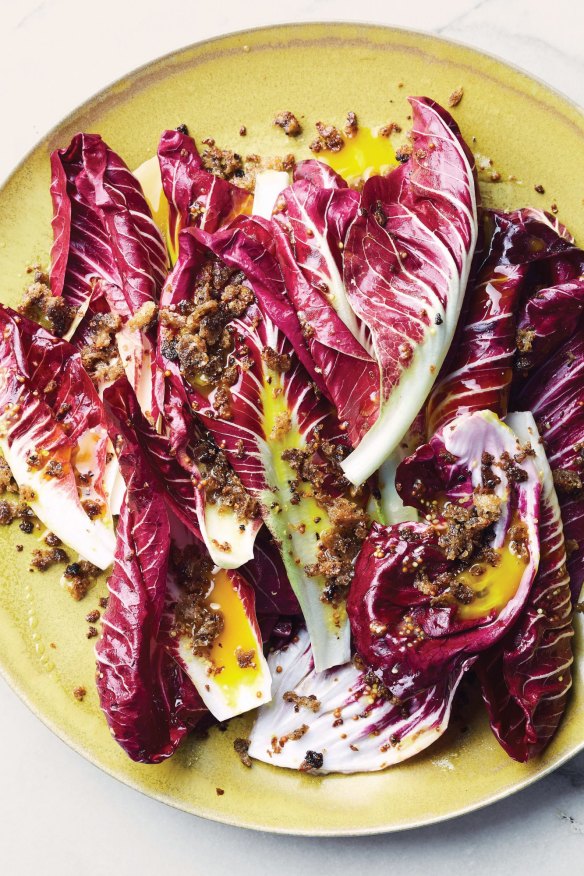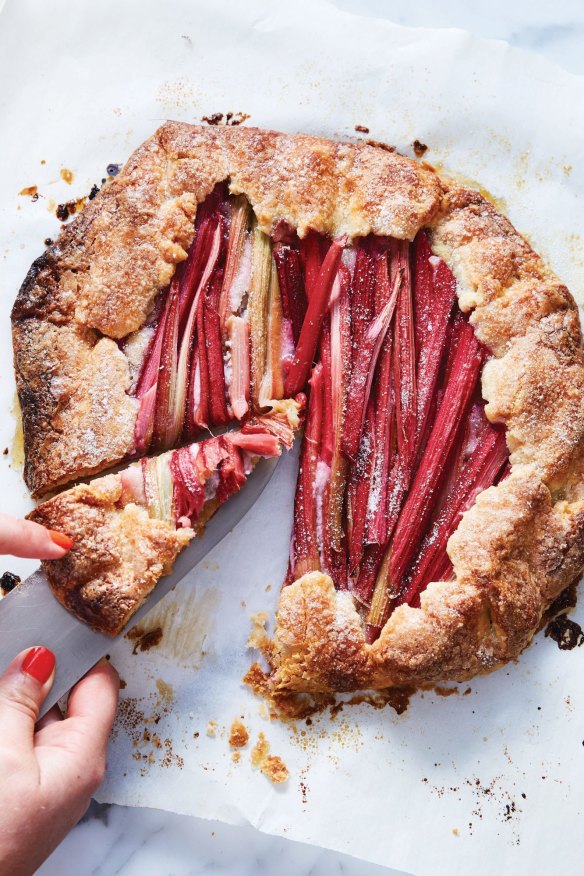DIY date-night dinner recipes from Alison Roman's 'Dining In'

For me, there's nothing more special or satisfying than cooking for your friends, family, lovers, or, perhaps most important, yourself. The recipes in Dining In are what I call "highly cookable", meaning they're easy to shop for, simple to execute, and a joy to eat. They prove that casual doesn't have to mean boring, and simple doesn't have to be uninspired, and that more steps or ingredients don't always translate to a better plate of food.
Fennel-rubbed pork chop for two
This is a thick, fancy Saturday-night chop, not thin, pedestrian Tuesday-night chops (only in spirit – you can definitely make this on a Tuesday). The breed of pork may vary but the thickness here, at least four centimetres, is non-negotiable. Larger chops, whether pork or steak, are fattier and richer in flavour, and are also nearly impossible to overcook. Even while searing them for what feels like forever, watching the outside develop a too-good-to-be-true deeply golden brown crust, the inside miraculously remains that perfect shade of pink and juicy as hell. You're not likely to find pork chops like this unless you go to a butcher's. But trust me, it's worth it and what makes these chops so dang special. The fennel seed mixture can be made two weeks ahead and stored at room temperature. It is also great on chicken.

INGREDIENTS
1 tbsp fennel seeds
1 tbsp soft brown sugar
2 tsp salt, plus more as needed
½ tsp freshly ground black pepper
1 × 575g bone-in pork chop, about 4cm thick
1 tbsp canola oil
1 fennel bulb, sliced lengthways 5mm thick
15g (½ cup) herbs, such as flat-leaf parsley, coriander, dill and/or tarragon
1 tbsp finely grated lemon zest
METHOD
1. Toast the fennel seeds in a small frypan over medium heat, swirling the pan, until the seeds start to smell fragrant and turn a light golden brown, about two minutes. Remove from the heat and grind in a spice grinder, pound with a mortar and pestle, or finely chop with a knife.
2. Combine the fennel seeds with the brown sugar, salt and pepper, and rub the mixture all over the pork chop. Cover and let it sit for at least 30 minutes at room temperature, or up to 24 hours in the refrigerator.
3. Heat the canola oil in a large frypan over medium-high heat. Sear the pork chop until it's super browned and caramelised on one side, five to eight minutes. Flip the pork over and add the sliced fennel to the pan. Cook, stirring the fennel every so often, until it is tender and golden brown, trying not to disturb the pork chop. Cook until the deepest part of the pork chop registers 62C on an instant-read thermometer, another eight to 10 minutes; if you don't have a thermometer, you can cut off an end piece and check for proper pinkness. Transfer the meat to a cutting board and let it rest for a few minutes.
4. Meanwhile, combine the herbs and lemon zest in a small bowl, and season with salt.
5. Serve the sliced pork alongside the fennel, with the lemony herb mixture sprinkled on top.
Serves 2
Radicchio with anchovy breadcrumbs and egg yolk
I am in love with raw egg yolks. Here they're plopped onto a nest of hearty radicchio and chicory, showered with salty anchovy breadcrumbs, and broken just before serving to become the world's greatest low-maintenance salad dressing.

INGREDIENTS
3 tbsp olive oil
2 tbsp wholegrain mustard
1 tbsp lemon juice
salt and freshly ground black pepper
1 head of radicchio, halved lengthways and leaves separated
1 head of endive (witlof/chicory), quartered lengthways
4 large egg yolks
100g (1 cup) salty anchovy breadcrumbs (see recipe)
METHOD
1. Whisk the olive oil, mustard and lemon juice together in a small bowl and season with salt and pepper.
2. Using your hands – yes, your hands! – rub the dressing onto the radicchio and chicory, between the leaves and whatnot, taking care not to crush the life out of them. Season them with salt and lots of pepper.
3. Nestle the egg yolks somewhere in there so they are cradled by the leaves, then season them with salt and pepper, too. Make sure whoever serves first breaks the yolks to create "the dressing"; alternatively, you can whisk the egg yolks together in a small bowl and drizzle over the leaves.
4. Scatter the breadcrumbs over the top, serving any extra on the side, because you'll want them.
Serves 4
Salty anchovy breadcrumbs
When you need a salty, punchy crumb to stand up to aggressive salads, or to liven up otherwise simple roasted vegetables, look no further than these breadcrumbs. Don't worry about chopping up the anchovies; they'll dissolve right into the olive oil, just like magic. These breadcrumbs can be made two days ahead and refrigerated. Rewarm them in a frypan before using.
INGREDIENTS
60ml (¼ cup) olive oil
6 anchovy fillets
160g (2 cups) fresh breadcrumbs or panko breadcrumbs
salt and freshly ground black pepper
1 garlic clove, finely chopped
METHOD
Heat the oil in a large frypan over medium heat. Add the anchovies and, using a wooden spoon or spatula, move them around in the oil until they've dissolved into a delicious paste; this will happen almost immediately. Add the breadcrumbs and season with salt and pepper. Cook, stirring pretty frequently, until the breadcrumbs start to turn golden brown, about four minutes. Add the garlic and toss to coat. Continue cooking and tossing until the breadcrumbs are a deep golden brown and crisped, another two to three minutes. Transfer to a small bowl and let cool before using.
Makes 200g (2 cups)
Rhubarb-almond galette
Too tart for some, too stringy for others, rhubarb is a vegetable struggling to find its place in a fruit world. But when baked in a galette, it maintains its lovely shape, showing off that vibrant pink colour and competing for the title of Most Delicious Fruit.
INGREDIENTS

1 large egg, lightly beaten
½ quantity (1 disc) The Only Piecrust (recipe below)
plain flour, for dusting
60g (¼ cup) almond paste (marzipan)
1.15kg rhubarb, halved lengthways, then cut crossways into 10-15 cm pieces
110g (½ cup) sugar
vanilla ice-cream (optional)
METHOD
1. Preheat the oven to 190C.
2. Beat the egg with one teaspoon water and set aside; this is your egg wash, which will help the crust get super golden brown on top.
3. Roll out the pie dough on a lightly floured surface, to a round about 35-40cm in diameter.
4. Transfer the dough to a tray lined with baking paper.
5. Flatten large bits of almond paste between your palms until they are super thin (3-4mm) and place them on top of the dough, leaving a five-centimetre border. Arrange the rhubarb pieces over the almond paste. Don't worry about placing them in any sort of pattern; just have them roughly stacked.
6. Fold the edges of the dough up and over the rhubarb. Brush the edges of the dough with the egg wash and sprinkle the whole thing with sugar, throwing most of it on top of the rhubarb. (Remember, the almond paste is pretty sweet, so you don't need as much sugar as you think you might.)
7. Place the galette in the oven and bake until the crust is golden brown (the colour of a roasted cashew), 50 to 60 minutes. Let it cool slightly before eating with the best vanilla ice-cream you can find.
Serves 8
The only piecrust
Because it's such a tactile process, I always prefer to make my dough by hand, never in a food processor. When you feel the butter smash into the flour, then the water hydrate the flour, you're much more connected to and in charge of the outcome, fully understanding what it means to need a few more teaspoons of water or a light dusting of flour. This dough can be tightly wrapped and refrigerated for four days, or placed in a Ziploc bag and frozen for one month.
INGREDIENTS
375g (2½ cups) plain flour, plus more for rolling
2 tsp sugar
1 tsp salt
250g unsalted butter, cut into 2.5cm pieces, chilled 1 tbsp apple cider vinegar or white vinegar
60ml (¼ cup) ice water
METHOD
1. In a large bowl, whisk the flour, sugar and salt together. Add the butter and toss to coat it in the flour mixture. Using your hands, smash the butter between your palms and fingertips, mixing it into the flour, creating long, thin, flaky, floury, buttery bits. Once most of the butter is incorporated and there are no large chunks remaining, dump the flour mixture onto a work surface.
2. Combine the vinegar with the ice water and drizzle it over the flour mixture. Run your fingers through the mixture like you're running your fingers through your hair, just to evenly distribute the water through the flour until the dough starts coming together.
3. Knead the dough a few more times, just to gather up any dry bits from the bottom and place them on the top to be incorporated. Once you've got a shaggy mass of dough (it will not be smooth and it certainly will not be shiny), knead it once or twice more and divide it in half. Pat each piece into a flat disc, about 2.5 centimetres thick. Wrap each disc individually in plastic wrap and refrigerate for at least two hours.
Makes 2 discs, enough for 1 double-crust pie, 2 galettes or 12 hand pies
This is an edited extract from Dining In by Alison Roman published by Hardie Grant Books RRP $48. Food photographs: ©Michael Graydon and Nikole Herriott. Alison's follow-up, Nothing Fancy, will be published on November 4 and is available for pre-order.
